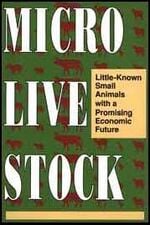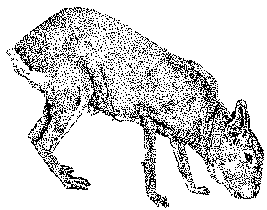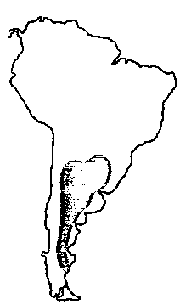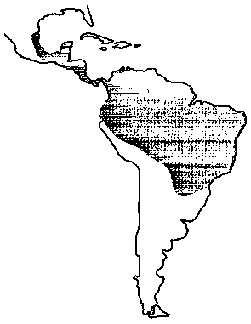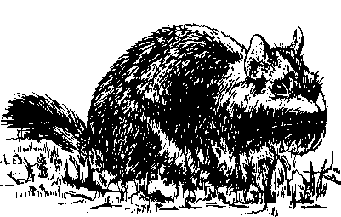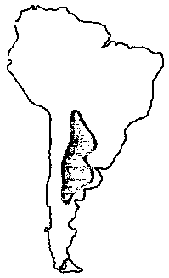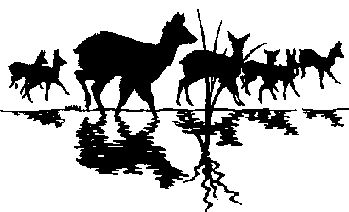22 Mara[edit | edit source]
Many wild relatives of the guinea pig are native to South America. Some, such as the guinea pig itself, are small; others, such as the mare, are much bigger. Maras1 (Dolichotis patagonum) are as tall as terriers and, at first glance, look like dwarf antelopes or huge hares They have large ears and eyes, long legs, and short tails. They generally behave like hares or wild rabbits, but, like deer, they run with a stiff-legged gait when pursued by predators.
These strange-looking creatures are found in temperate regions in the southern half of South America. They are dry-country animals, living on the thorn-scrub, desert plains of Argentina and the stony wastes of Patagonia.
Although exceedingly shy, restless, and watchful, mares tame easily, make good pets, and are much favored by the local populace. They were introduced to France last century, and in Victorian times Europeans sometimes bred them. These big, handsome rodents, grazing in little herds, were considered an attractive addition to the lawns of country estates.
POTENTIAL AREA OF USE
Maras are best kept in their native region of southern South America. With care, however, they could be used in other areas because they are slow breeders and their population growth is easy to control.
APPEARANCE AND SIZE
At first sight, these large rodents look like some weird hybrid. They have the long ears of a hare and the tidy body and spindly legs of a small antelope. Although related to guinea pigs, they are long legged. The tail is short; the ears are long and erect.
Average-size mares weigh about 8 kg, but large ones can be 1 m long and weigh up to 16 kg.2 Females are larger than males. The coat is light in color, with grey upper parts and whitish underparts. The limbs and feet are tinged a yellowish brown. The pelage is dense, with individual hairs standing at nearly right angles to the skin. This gives a harsh texture, even though the hairs are soft and fine.
These animals can hop, walk, gallop, or run. They are extremely swift and can reach 45 km per hour over long distances. They are also accomplished jumpers, often leaping 2 m high from a standing start. The feet are compact and rather hooflike, but with sharp claws. The hind foot has three digits; the front foot has four.
DISTRIBUTION
The mare's range in the thorn-scrub desert and Patagonian steppe of Argentina extends from about 28°S to 50°S.
STATUS
Endangered. These animals, once plentiful, are now threatened because of the introduction of the European hare, which is more successful at competing for food. In many of the eastern parts of its distribution (see map) it is now extinct.
HABITAT AND ENVIRONMENT
Maras inhabit open, dry plains and other treeless semidesert areas of coarse grass or scattered shrubs.
BIOLOGY
Maras are pure vegetarians. They feed on short grasses and herbs that are sparsely distributed between patches of dry desert scrub. Usually, they are satisfied with a few coarse weeds and the shoots of bushes. However, their overall diet consists of any available vegetation: leaves, roots, fruits, and stems.
Female mares become sexually receptive within a few hours after giving birth. The estrous cycle is 35 days, plus or minus 5 days.3 The gestation period is 77 days. Each female gives birth to 1-3 young at the mouth of the den; the pups crawl inside to safety. Newborns are well developed, and within a few hours they begin grazing vegetation. They remain in the vicinity of the den for up to 4 months.
Initially, at least, the young are nervous and easily frightened.
BEHAVIOR
Maras shelter in a burrow that they either construct for themselves or "borrow" from another animal that has abandoned it. They are active during the day and spend considerable time basking in the sun. They are always alert for danger. When alarmed, they flee at high speed. The white rump patch flashes a warning to the others, who then follow this "flag."
A fundamental element of their social system is the monogamous pair bond. Certainly in captivity, and probably in the wild as well, the bond between a pair lasts for life. When breeding, 20 or more pairs may band together temporarily to share a single den for the pups.4
The animals stand on straight legs, sit on bent haunches with the forepart of the body resting on the fully extended front legs, or recline in a catlike position with the front legs folded under the chest, an unusual position for a rodent. They travel in single file, with the female usually leading. Members of a pair maintain contact by means of a low grumble. Although the long legs can quickly carry it to safety, a mare usually stops every 20-30 m and turns to peer at its pursuer.
The animals clean themselves by licking their sides and apparently by "combing" their fur with their teeth. They wipe their faces as cats do, with the inside of a foreleg.
USES
Although the light-colored meat is said to be dry and flavorless, it is widely consumed in South America.
HUSBANDRY
Maras have been successfully raised and bred in many zoos, and, as noted, have been kept as pets.
Adults make little use of any shelter; they seem fond of being out and about in all weather. As long as they have a protected burrow for the use of the pups, mare populations can thrive in severe climates.
In zoos, diets include straw, vegetables, and crushed oats. Drinking water is supplied, although the animals rarely take it if they are feeding on fresh plant materials. They like to have salt blocks, however.
In South America, one mare lived in captivity for almost 14 years; most specimens do not live beyond 10 years.
ADVANTAGES
Maras are a good size for microlivestock. They have a short gestation period, and they are social and easy to maintain in groups. They can be successfully kept in pens and can be fed relatively low-quality forage. Colonies can grow to be quite large.
LIMITATIONS
These animals can easily dig under the edges of cages and escape. Extra-deep foundations are needed.
Following heavy rains, care must be taken to keep them from drowning in their subterranean burrows.
If suddenly disturbed, mares can become hysterical, leaping away regardless of anything in the way, and often seriously injuring or even killing themselves as a result. They fear bodily contact.
The mare's monogamous nature in the wild is a likely limitation. But perhaps, like chinchillas, the animal will become polygamous in captivity.
The animals are sensitive to tuberculosis when kept in humid conditions.
RESEARCH AND CONSERVATION NEEDS
Research needs to increase understanding of the mare include:
- Nutritional trials;
- Husbandry experiments - measurements of growth rates, space requirements, feed needs;
- Productivity tests;
- Grazing-efficiency measurements;
- Exploration of commercial details; and
- Determination of diseases and parasites.
23 Paca[edit | edit source]
Pacas (Agouti paca)1,2 are large, white-spotted, almost tailless rodents with the potential to become a source of protein for the American tropics. They are found in lowlands from Mexico to northern Argentina. The meat is white and is considered the best of all Latin American game meat. It is common in local markets and restaurants. Tasting like a combination of pork and chicken, it sells at higher prices than beef and is a regular item of diet in some areas. In Costa Rica, pace is served on special occasions such as weddings or baptisms. It has a higher fat content than the lean meat of agoutis, rabbits, and chickens, and has no gamy taste.
Paca has promise as a microlivestock. In several countries, Belize and Mexico for example, people already keep them in cages beside their homes and fatten them on kitchen scraps. In Costa Rica, some are bred on farms, under houses, and even in apartments. Research on raising paces in captivity is under way at the Universidad Nacional in Heredia, Costa Rica; at the Smithsonian Tropical Research Institute in Balboa, Panama (see page 196); and at the Instituto de Historia Natural in Tuxtla Gutierrez, Mexico. In Turrialba, Costa Rica, an entrepreneur is already breeding and raising pace commercially.
While the pace has potential as a food source, many problems still must be resolved before it can be recommended for mass rearing. If solved, however, this species would become an attractive microlivestock.
AREA OF POTENTIAL USE
The pace has potential for use throughout its vast geographical range in Latin America.
APPEARANCE AND SIZE
In general appearance, paces are somewhat like giant guinea pigs. The legs are short, the forefeet have four "fingers," and the hindfeet have five small, hooflike "toes." The feet are partially webbed and are adapted both for digging and for swimming. Pacas burrow with all four feet as well as their teeth; even large roots are no obstacle.
Adults weigh 6-14 kg, males being somewhat larger than females. Although they may become bulbously fat, paces remain "one of the fastest things on four feet. " From a standing start, even a fat specimen can jump at least 1 m off the ground. Pacas are also agile. However, their skin's epidermal layer is thin and fragile, and large strips may be ripped off as they rush headlong through spiky undergrowth. However, such wounds heal astonishingly fast - frequently within days.
Pacas are chocolate brown in colon The head is somewhat lighter in shade than the body, and the underparts are whitish or buff colored. There are usually four longitudinal rows of white spots that may merge into stripes along each side of the body. The fur is coarse, spiny, and slippery, and has no underwool. Each hair is stiff, relatively sharp, and very smooth, which makes paces extremely difficult for predators to hang on to.
Parts of the cheekbones are enlarged, and the cheeks can open to form special pouches. This is more developed in adult males than in females - indeed, adults can be readily sexed by head shape. The pouches are outside of the mouth and are fully haired. The animals use them mainly to create a resonating chamber for their booming bark and noisy tooth grinding. These enlarged cheeks push the large bulging eyes toward the top of the skull. The eyes are suited for nocturnal conditions, the senses of smell and hearing are uncannily acute, and there is an array of long whiskers that is used when maneuvering at night.
DISTRIBUTION
Lowland paces are found throughout most of Latin America from east central Mexico to northern Paraguay, Argentina, and Minas Gerais, Brazil. This includes all of Central America and most of Colombia, Ecuador, Peru, Venezuela, and the Guianas. The animal has also been introduced into Cuba.
STATUS
Burgeoning human populations are severely reducing many of Latin America's native animal resources, and the pace is one of the most persecuted. It has been exterminated within hunting range of virtually all cities, towns, and villages.
Several governments, recognizing the pace's plight, have passed laws prohibiting the hunting and marketing of its meat. Nevertheless, people continue to take it, usually at night, using trail dogs and headlights.
vHABITAT AND ENVIRONMENT
Pacas thrive in a variety of tropical habitats but are most common in forests, swamps, and partly cleared grazing lands. They inhabit most types of forests from deciduous woodland to rainforest. Usually, they stay near streams or rivers, but they often live where there is no permanent water. They are abundant only in little-disturbed forest areas. Although preferring low, dense tree cover, paces sometimes inhabit open rocky areas and farmland.
BIOLOGY
These herbivores feed mainly on fruits, young seedlings, and some seeds. However, when fruits are scarce they may switch to browsing leaves and roots. They probably sometimes eat large insects, and, on rare occasion, may perhaps eat small vertebrates. Captive paces, like many other "frugivores," seem to develop a protein deficiency and will eagerly eat meat scraps on occasion.
The young are usually born singly after a gestation period of 146 days. There are probably 2 births a year. Females have an estrous period that begins shortly after giving birth. If mating does not take place at this time, the female becomes unreceptive until after the 3-month (sometimes 4- to 6-month) lactation is over. The length of the estrous cycle is 30 days.
During daylight hours, paces seclude themselves in brushy cover, in or under fallen logs, or in extensive underground burrows. The burrows, which may be several meters long, are dug in moist soil or taken over from other animals; they are often in river banks, on slopes, among tree roots, or under rocks. Usually, several exits are provided, often being plugged with leaves as a disguise.
BEHAVIOR
In the wild, paces dig large holes and rummage about the forest floor at night, gnawing on fruits. Pairs inhabit a defended area, sometimes living together in the same burrow, sometimes not. Also, they usually travel alone, following paths that lead to feeding grounds and water. Individual home ranges are small (1-3 hectares).
Although paces are terrestrial, they enter water freely, they swim well, they copulate in water, and, when alarmed, they generally attempt to escape by swimming. They are also lively and playful; however, they can be exceedingly obstinate. Sometimes fighting among themselves becomes very savage. When angered they growl, sometimes noisily, and they can suddenly jump on aggressors, real or imagined, delivering frightful wounds with their chisel-like front teeth thrust forward like a spear.
USES
As noted, pace meat is tasty and brings high prices in the markets. It is considered a delicacy in fine restaurants and was served to Queen Elizabeth during her October 1985 visit to Belize. In Mexico, paces, like pigs, are usually boiled unskinned. Even the skin is then edible.
HUSBANDRY
If treated appropriately when young, paces become manageable. They undergo "imprinting," a characteristic of most species that have been domesticated. An imprinted pace becomes so tame that it seeks out human company, follows people around like an amiable dog and, if turned out of its cage, returns voluntarily. (To achieve this degree of tameness it is necessary to remove the animal from its mother at an early age.)
Although wild paces are almost entirely nocturnal, tame paces are more active during daylight hours.
Young or partly grown paces are commonly exhibited in zoos. They eat prodigious quantities of almost any vegetation and have been called, "a good substitute for a large garbage pail." Diets can include rolled oats, raw vegetables, bananas, apples, and bread. They probably need additional protein occasionally, and seem to appreciate some fat in their diet.
ADVANTAGES
If husbandry can be developed, the clamor for pace meat throughout tropical America would be a big economic incentive for farming these animals. The excellence and wide acceptance of the meat is an indication that pace farming would be taken up both in rural and urban areas and by many levels of society.
LIMITATIONS
Pacas can harbor human diseases, including leishmaniasis and Chagas' disease.
Apart from the project in Panama (see page 194), paces have bred only sporadically in captivity, with few offspring surviving. However, successes have been recorded in zoos in London, San Diego, and Washington, D.C., and in a research project in Tuxtla Gutierrez, Mexico. In Costa Rica, they are also reportedly breeding well, with a survival rate of 90 percent since 1982, and 80 percent of the females are reproducing.3
All adult paces can be aggressive and dangerous. Their powerful incisors can inflict serious wounds. (They can even rip through planks.) Intraspecific aggression is one of the most serious impediments to captive breeding.
Unlike the capybara, the pace not only has a long gestation but usually bears a single young. Thus, the output of a single breeding female may be, at best, two offspring per year (at least this is the expected production in the wild). This "slow" breeding is a limitation. In captivity, however, there is a possibility that it can be speeded up.4 The fact that paces bond together in pairs is a limitation. If every female has to be accompanied by a male, then many (otherwise unnecessary) males have to be fed and maintained.
Male paces are considered difficult to keep as household pets because they spray females (or human substitutes) with a mixture of urine and glandular secretions. This can occur several times a day. In addition, they have anal glands that produce a musky odor that some people find objectionable.
RESEARCH AND CONSERVATION NEEDS
Although paces are common in some areas over the vast region from Mexico to Argentina, they are little understood, even by zoologists. In fact, most data concerning this animal have come from interviews with local hunters. Intensive field work is needed to develop an understanding of the pace's biology, status, and habitat requirements.
The popularity of pace meat makes it urgent to start this work as well as to begin breeding paces on an organized basis. Such projects would lay the groundwork for preserving the species.
Particular research needs concern the following:
- Age structure and reproductive performance;
- Growth rates and feeding habits;
- Behavioral patterns in captivity;
- Nutritional requirements;
- Meat quality;
- Helminth and arthropod parasites;
- Role in transmitting or perpetuating diseases;
- Reproduction (such as external manifestations of estrus in females); and
- Genetic variations that would allow the selection of animals adapted to captivity and females that produce multiple offspring - twins, triplets, or more.
Ways must be found to introduce more than one female to each male without inciting aggression.
24 Vizcacha[edit | edit source]
Vizcachas (Lagostomus maximus) are soft-furred South American rodents that look like long-tailed guinea pigs. They can weigh as much as 8 kg and are resilient animals, inhabiting dry pampas and shrub lands in northern Argentina and neighboring countries. They seem to have promise for producing meat and hides in marginal zones whithin their native habitat.
Like chinchillas, these rodents provide a prized furry pelt. They also provide meat that reportedly tastes "as good as hare," which in Europe is considered the epitome of dining. They are easily trapped alive in cheap, homemade, multiple-catch, funnel traps. And they are thought to be suitable for farming on a large scale.
On the other hand, vizcachas are currently considered pests because they take grazing from cattle and sheep and because they build large burrows that undermine the land. Government campaigns have eradicated them in the richer agricultural areas of Argentina, but the animals are still common in marginal zones. There is evidence that they become more abundant when domestic livestock overgraze the land. In improverished marginal sites, where other livestock enterprises are unsuitable, the potential exists for game-ranching vizcachas.
AREA OF POTENTIAL USE
Because of the potential hazard to new areas, vizcachas can be used only in the pampas regions of southern South America where they are already widespread.
APPEARANCE AND SIZE
Vizcachas have short front legs, long, muscular hind legs, and round eyes and ears. Their heads seem oversized in proportion to their bodies. Males weigh 5-8 kg, females 2-4.5 kg.
Members of the same rodent subfamily as the chinchilla, they have a thick, soft, valuable fur that is grey or brown above, whitish or greyish below. They are, however, much larger than chinchillas.
Although basically running animals, vizcachas often jump bipedally (like kangaroos), and they sit erect while eating or grooming. The forefeet have four long flexible digits used to grasp food. Their soles and palms are naked and have fleshy pads (pallipes).
DISTRIBUTION
Vizcachas once swarmed widely over the savannas of southern Paraguay, Bolivia, and Argentina, but they are being systematically exterminated. Today they inhabit isolated areas of north, central, and western Argentina and southern Paraguay.
STATUS
Since 1907, these animals have been mercilessly hunted. The governments of the Argentine provinces where they are mostly found, reward hunters for killing this "pest." However, the numbers are so reduced that now there is no need for a bounty system.
HABITAT AND ENVIRONMENT
Vizcachas live in flat, dry, steppelike plains; in dry woodland (Chaco), and in low mountains.
BIOLOGY
The fact that these rodents eat their own droppings (coprophagy) augments their ability to utilize natural forages, and allows them to abound in degraded zones. They feed on any plant materials they can find near their colonies, particularly grasses. In feeding trials, their daily dry matter intake was 2-5 percent of the body weight. The metabolic efficiency (dry matter per kg) was 33-56 percent; the digestive efficiency was 50-60 percent.2
Male vizcachas become sexually mature at about seven months of age and remain fertile throughout the year. The gestation period is long: 154 days. Litters contain one or two young. Newborns are well developed, fully furred, and open eyed, although they cannot fend for themselves for at least three weeks. In the wild, one or two litters are reared each year.
BEHAVIOR
Vizcachas are nocturnal and are active year-round. They inhabit underground burrows, living in colonies often containing many individuals. They collect a variety of materials (for example, bones, sticks, and stones), and heap them in piles above the entrances to their burrows.
Their hearing and sense of smell are acute.
USES
Vizcachas have long been hunted for food as well as for their fur. Their meat is often consumed in pickled form in southern South America.
The skins are fabricated into table runners, rugs, bedspreads, slippers, and belts. The skins are also popular for overcoats.
Vizcachas can be kept in captivity without major difficulty.
HUSBANDRY
In zoos, vizcachas are fed the typical diets furnished for vegetarian rodents: rolled oats, green vegetables, bananas, apples, and bread. They are usually kept indoors in wire-fronted cages, about 1 x 2 m in size, and provided with sleeping boxes.
Little is known about vizcacha husbandry, but in one trial, weight rose most rapidly in males until age 18 months (the average size was then 5.3 kg) and subsequently slowed. The heaviest male was 7.3 kg at 30-32 months. The female's weight gain was greatest until 16-18 months (average size 3.3 kg).3
ADVANTAGES
The animals seem well adapted to harsh sites where the climate and forage make raising conventional livestock difficult.
The meat is white and has a good nutritive value because of its high digestibility, low levels of saturated fats, and high levels of proteins.
In marginal zones of the pampas, these rodents appear far more productive than traditional livestock.4
LIMITATIONS
Vizcachas may do considerable damage by foraging in cultivated crops. As noted, ranchers claim that they take grazing away from domestic animals, 10 vizcachas eating as much as a sheep. In addition, they claim, vizcachas destroy pasture with their acidic urine. And the large burrow systems sometimes create a hazard.
Because their reproductive rate is low and their growth rate is only moderate, their commercial breeding might not be profitable except in well-designed projects with clear markets.
Vizcachas require sturdy pens, which implies a high initial cost for materials such as concrete and brick.
Vizcachas can be aggressive to one another, especially in captivity.
RESEARCH AND CONSERVATION NEEDS
There are several possible research projects, including:
- Gathering specimens from different regions for comparative evaluation of characters such as biology, chromosome type, reproductive physiology, social behavior (both in its wild state and under controlled conditions);
- Attempting captive rearing and small-scale husbandry;
- Assessing performance under various environments; and
- Quantifying productivity and population dynamics in relation to rangeland use and improvement practices.
A rational cropping program based on wild stocks is perhaps more viable than captive breeding. This could be organized so as to keep vizcacha numbers in check while sustaining a small chain of processing plants by providing a constant supply of meat and skins.
25 Other Rodents[edit | edit source]
The 10 previous chapters have described some rodent species that show promise as microlivestock. Rodentia, however, is one of the largest families of mammals, and the species highlighted by no means exhaust the possibilities. In this chapter we briefly mention others that deserve consideration and exploratory research. These might prove to be potential resources, at least in localized situations. Several are fast nearing extinction and they deserve protection and immediate attention from animal scientists.
CHINCHILLAS
In the high Andes of South America are found the short-tailed chinchilla (Chinchilla brevicaudata) and the long-tailed chinchilla (Chinchilla lanigera). These plump little rodents have fur that is possibly the thickest, softest, and warmest of any animal's.
On the surface they would seem to be ideal candidates for microlivestock in Third World regions. Indeed, in recent years chinchilla-rearing has been successfully carried out in northern India. However, raising these animals for commercial markets is a highly specialized and costly business because only rare and expensive breeding stock produces top-quality pelts, and all other pelts are worthless in today's marketplace.
These guinea-pig-sized animals have round ears, a bushy tail, and range from 25 to 50 cm long. Adult males rarely weigh more than 500 g, but females may weigh up to 800 g.
PACARANA
The pacarana (Dinomys branickii) is the third-largest living rodent- only capybaras and some beavers are larger. But little is known about this seldom-encountered, forest-dwelling species. Nevertheless, pacaranas appear to be likely candidates for domestication. They are amazingly even-tempered and peaceful, and become surprisingly tame.
Because these animals are endangered they are unlikely candidates for microlivestock in the short run, but their large size and good meat could be the stimulus for an international effort to study, protect, and rear them in large numbers before it is too late.
Pacaranas are found along the eastern foothills of the Andes, including parts of Bolivia, Brazil, Colombia, Ecuador, and Peru. Their area of potential use is in Latin America and the Caribbean.
It would be advantageous for livestock scientists to investigate this species in captivity. Studies are needed of the animal's general biology, including its nutritional requirements, reproductive capacity, behavior, and physiology. For wildlife specialists, there is a compelling need to protect this species.
SPRINGHARE
Scattered through the dry lands of eastern and southern Africa - on numerous grasslands, plains, fossil lake beds, hill slopes, and floodplains - is the springhare (or springhaas). With its powerful hind legs, tiny forelegs, upright stance, and hopping gait, it looks something like a tiny kangaroo. It is commonly seen at night, eyes glowing a characteristic red in the headlights.
This animal is an important source of food and skins for rural peoples throughout southern Africa. In Botswana, it is the principal bushmeat in the human diet.
Springhares are 35-40 cm long and weigh 3-4 kg. There is one species (Pedetes capensis) and two subspecies: the East African springhare and the Cape springhare (formerly Pedetes cafer).
ROCK CAVY
The rock cavy (Kerodon rupestris) is closely related to the guinea pig and occurs in the impoverished semiarid region of northeastern Brazil. It is large and lean and has a face somewhat resembling a dog's. It is hunted extensively and is an important source of meat for country people, who consider it a delicacy.
This creature might be suitable as a microlivestock. It consumes leaves and bark, and breeds well in captivity. Famine is a serious periodic problem in the often-drought-stricken area, and protein deficiency is common. The rock cavy, like the guinea pig, may be amenable to domestication and may be able to provide the people with better nutrition. However, it is difficult to keep in a cage because it moves fast, climbs well, and easily slips out.
Because these rodents occur in rare and patchily distributed habitats, they are in desperate need of protection, whether or not they prove to have any long-term utility.
SALT-DESERT CAVY
A smaller relative of the mare (page 256), the salt-desert cavy (Dolichotis salinicola) is rabbitlike in appearance and behavior. It has large ears and eyes, long legs, and a short tail. It lacks the mare's white rump patch.
This animal inhabits dry, salty areas of the Chaco desert, particularly areas of dry, woody brush. Specifically, it is found in the saline western Chaco of Paraguay and northwestern Argentina, as well as in the extreme south of Bolivia. It is about 45 cm long and weighs up to 4 kg.
Although it might make a useful microlivestock in its native habitat, the salt-desert cavy breeds rapidly and can cause much devastation; it should never be introduced to new regions.
The salt-desert cavy's life in the wild is largely unknown; however, some have been successfully raised and bred in zoos. Exploratory research on keeping and managing these little creatures is warranted.
OTHERS
As noted earlier (page 193), it has been estimated that 42 peoples of various cultures eat rodents. Most of these eat locally available species, some of which are listed below. Whether any have long-term usefulness is uncertain, but study of them in the wild and in captivity could result in some interesting and valuable scientific discoveries.
Solomon Islands Rodents
The Solomon Islands in the southwest Pacific are home to a collection of six rare giant rodents that live in the rainforest canopy. At one time they were important food items. Archeologists have dug up tens of thousands of rodent bones on sites where people lived as long as 30,000 years ago. These mysterious animals were classified last century, but most have not been seen by biologists for decades. However, one, the thinking rat (Solomys sapientis), was rediscovered in 1987 - the first time it had been reported seen since 1901. The others may also be inhabiting the dense and undisturbed forests.'
The thinking rat was located on the island of Santa Isabel. It proved to be gentle, unafraid, and friendly. It lives in the forest canopy, weighs up to 1 kg, and feeds on nuts and fruits. Efforts to build up the population are urgently needed. The other species should also be sought.
Such animals could be a resource for rainforest production (perhaps in the manner of butterfly farming in Papua New Guinea2). They may never be plentiful enough to be food sources again, but they could nonetheless become valuable. Zoos the world over are likely first customers for these scientific curiosities if production can be boosted and the populations secured.
Giant New Guinea Rat
The giant New Guinea rat (Mallomys rothschildi) is often eaten in New Guinea. It is little known to science but is odorless and easily tamed. It grows so fast that it becomes as big as a guinea pig even before it is weaned. It feeds on a wide variety of tubers and vegetable products. An attractive species native to mountain forests, it has a long heavy tail and black fur with white ticking.
Porcupines
Porcupines, brush-tailed porcupines, and their relatives are distantly related to guinea pigs and are widely consumed as food in tropical regions. Examples are:
- Indian porcupine (Hystrix indica) and other species of South Asia.
- Cape porcupine (H. africaeaustralis) of southern Africa.
- Prehensile-tailed porcupine (Coendou prehensilis), which inhabits Central and South America. These nocturnal creatures live in the thick, leafy crowns of trees or in hollow trees or holes in the ground. Although often belligerent among themselves, they can be very friendly and tame toward humans.
Kiore
The kiore (Rattus exulans) was formerly an important component of the diet of most Polynesians, including the Maoris of New Zealand. It has been successfully reared in captivity in recent times. Unlike many other rodents, this animal is normally not a scavenger; it is a clean, even fastidious feeder that is basically a vegetarian (flowers, berries, nuts, and seeds) and is reckoned remarkably good eating.
Soft-Furred Rat
The soft-furred rat (Praomys) is relatively large and slender and is found in the tropical forests of Africa from sea level to more than 3,000 m. Among the most common rodents of the African jungle, it is trapped almost everywhere. It feeds largely on plants, but eats large quantities of ants and other insects. It has been raised successfully in captivity and is eaten by villagers in Malawi.
Giant Squirrels
The giant squirrel (Ratufa bicolor) occurs throughout Indonesia, Malaysia, and Sri Lanka. It is the largest squirrel on earth, almost the size of a cat. A related species, the palm squirrel (Funambulus), also gets very large. It can crop nuts in the very high treetops that are inaccessible to people. It is widely used as food.
Squirrels
Squirrels of the genus Callosciurus (notably C. notatus and C. prevostii) are significant pests on cocoa, oil palm, and mixed fruit plantations in Southeast Asia. They can be reared and bred on a diet of most types of fruit as long as a little protein, in the form of insects or cooked wheat, is available. The systematic use of this animal may offer a chance to turn a pest to advantage.
Cloud Rat
Two species of slender-tailed cloud rats (Phlocomys spp.) are found only in southeastern Asia. They live in tree cavities, climb well, and are well adapted to tree life.
One of these (P. cumingi) lives in the northeastern part of Luzon in the Philippines, where it appears to be thriving. It has a large body and long tail and is the largest member of the mouse subfamily.
The other (Crateromys schadenbergi) has long, thick hair and a thick, bushy tail. It lives in the mountainous areas of northern Luzon. A nocturnal animal, it feeds on buds, bark, and fruits.
Both are attractive, even fascinating, creatures that are relentlessly hunted for food. They might make useful livestock in forest situations.
Spiny Rat
The Cayenne spiny rat (Proechimys guyannensis) is found throughout most of South America. It is tasty, easily kept in captivity, and is popularly used in Colombia for food. A nocturnal animal, it is one of the most common mammals in many areas. It has been raised in captivity on bananas, sweet corn, coconut, grain, and various seeds.3
Bamboo Rat
The bamboo rat (Rhyzomys spp.) is the largest rodent on the island of Sumatra in Indonesia; it weighs 2-4 kg and the body can be as long as 45 cm. It prefers to live in bamboo thickets and is hunted and eaten by many local peoples.
There is a need - in considering any sort of game farming - to relate the animal's "preferred" conditions (range, feed, temperature, etc.) to the varying land and climate types not being effectively utilized. In other words, rather than looking at animals that might be farmed, it might be necessary to consider the terrain and climate and then seek animals that would "do" well under those conditions. One major fault with traditional farming has been the tendency to force traditional livestock onto unsuitable land. This has given rise to numerous serious problems. In many cases the most suitable use of an area is provided by several species grazing together to mutual benefit (e.g., goats and sheep on New Zealand hill country improve grazing for each other if ratios are right).
